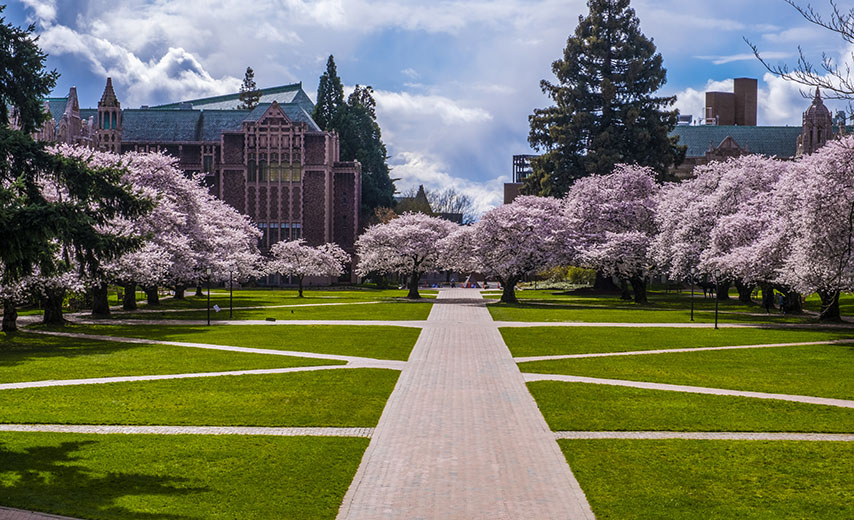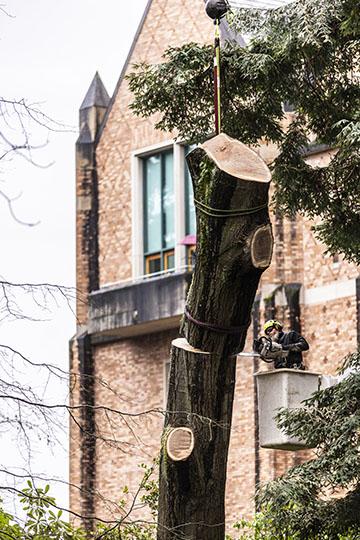What’s the future of the UW cherry trees?

Yoshino cherry trees have graced the Quad since 1961. Pamela Dore/University of Washington
Today, the Yoshino cherry trees in the UW’s Quad are as iconic to the University as Suzzallo Library and Drumheller Fountain. But it’s been 60 years since they were transplanted from the Arboretum, and even legends aren’t immortal.
In 1999, the UW alumni magazine published a story titled, “Time is running out on Quad’s signature cherry trees.”
Yet, the trees have bloomed beautifully year after year, attracting thousands of visitors each spring. They’ve even inspired their own merchandise, social media accounts, fun run and festival, along with tributes to their transcendent qualities.
So what does the future look like for the UW’s perennial pink beauties?
“Hopefully we get another 15 years out of them,” said UW arborist Sara Shores. “They're doing incredibly well. I mean, they're probably around 90 years old, and their lifespan is generally around 100 years.”
A few trees are showing signs of decay, but Shores and her colleagues are monitoring them. A pest called the cherry bark tortrix can infest the trees, but insecticides are used to prevent damage. These threats are why the UW asks people not to climb the trees. Damage to the bark can cause decay or become an entry point for moths to lay eggs.
Over the years, four trees have been removed from the Quad, leaving 29. The trees that have been removed since Shores started at the UW in 2006 were in areas where there is more moisture due to poor drainage.
The UW suspects at least one of the removed trees was dying due to brown rot, a fungal disease that travels through water. The region’s wet weather, together with poor drainage throughout the Quad and poor airflow between leaves, makes all the trees susceptible to this very common problem among Pacific Northwest cherry trees.
The next generation
The next generation
While the current trees may have 15 more years, the University is hoping to have pink blossoms for posterity. Shores and her colleagues are thinking ahead to future versions of the Quad cherry trees.
The UW contracted with a nursery to create clones of the existing trees, grafting cuttings on to rootstock. But time passed without them being needed. The clones were planted elsewhere on campus. You can now find them on Parrington Lawn, near the Waterfront Activities Center and near Laurel Village.
The current thinking is that the UW will remove each Quad cherry tree as it dies and plant the largest possible tree in its place.
When envisioning the future of the Quad, Shores dreams of the chance to fix the issues that make it hard for trees to thrive, but there aren’t any easy solutions. Ideally, the entire Quad would be relandscaped from the ground up, including fixing the drainage; installing new irrigation, lighting and a root barrier for the sidewalks; and moving the pathways slightly further from the trees.
“I could see just doing a whole revamp of the Quad, but that would be very disturbing to the tree roots and the trees,” she said.
When is a UW tree removed?
When is a UW tree removed?
The cherry trees are just one part of the University’s tree canopy, which includes around 570 species. And for 12 years in a row, the UW has received Tree Campus Higher Education recognition from the Arbor Day Foundation.
To earn this recognition, colleges and universities have to submit their plan for caring for the trees. This includes a policy for removing trees, which would be applied to the Quad cherry trees.
“It’s safety first and then aesthetics,” Shores said. “If a tree was removed, it might be because it was a hazard because a branch was decayed enough that it could potentially break and hurt somebody."
The UW wants to avoid a situation like what happened near Grieg Garden on the first day of autumn quarter in September 2023. A tree fell when its soil was saturated after extreme rain. The UW brought in a third-party consultant, and they did an ultrasound on the other trees around the garden, finding serious decay in two more trees. Given what had just happened in that area, the trees were removed a few months later.
The cherry trees also aren’t the only campus trees that are approaching the end of their lifespans. Big leaf maples, one of the aging population of trees on campus, make up 10% of the UW’s tree canopy, but they account for 25% of its hazardous trees.
“The problem is only going to get worse for that species because there's such a huge chunk of those within this age limit that are going to be moving into this next phase soon,” Shores said. “It's kind of like the baby boomer generation. They're all going to be collecting Social Security.”
Whatever the future holds, Shores and her team are working to make sure the UW is a beautiful tree campus — on and off the Quad — for years to come.
“You hear reports that people decide to come to a campus within the first few minutes, and a lot of that has to do with the buildings and the landscape,” she said. “When trees are around, it makes things better. We're doing what we can to keep the trees that we need and hopefully planting the ones that are going to make it into the next 20 to 100 years.”




